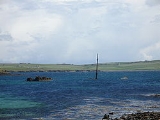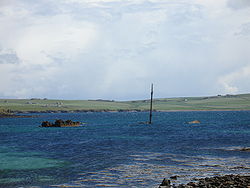
Blockship
Encyclopedia

Ship
Since the end of the age of sail a ship has been any large buoyant marine vessel. Ships are generally distinguished from boats based on size and cargo or passenger capacity. Ships are used on lakes, seas, and rivers for a variety of activities, such as the transport of people or goods, fishing,...
deliberately sunk to prevent a river
River
A river is a natural watercourse, usually freshwater, flowing towards an ocean, a lake, a sea, or another river. In a few cases, a river simply flows into the ground or dries up completely before reaching another body of water. Small rivers may also be called by several other names, including...
, channel
Channel (geography)
In physical geography, a channel is the physical confine of a river, slough or ocean strait consisting of a bed and banks.A channel is also the natural or human-made deeper course through a reef, sand bar, bay, or any shallow body of water...
, or canal
Canal
Canals are man-made channels for water. There are two types of canal:#Waterways: navigable transportation canals used for carrying ships and boats shipping goods and conveying people, further subdivided into two kinds:...
from being used.
It may either be sunk by a navy defending the waterway to prevent the ingress of attacking enemy forces, as in the case of HMS Hood
HMS Hood (1891)
The second warship to be named HMS Hood was a modified Royal Sovereign-class battleship of the Royal Navy, and the last of the eight built. She differed from the Royal Sovereign class in that she had cylindrical gun turrets instead of barbettes, a lower freeboard and a higher metacentric height...
at Portland Harbour
Portland Harbour
Portland Harbour is located beside the Isle of Portland, off Dorset, on the south coast of England. It is one of the largest man-made harbours in the world. Grid reference: .-History:...
; or it may be brought by enemy raiders and used to prevent the waterway from being used by the defending forces, as in the case of the three old cruiser
Cruiser
A cruiser is a type of warship. The term has been in use for several hundreds of years, and has had different meanings throughout this period...
s HMS Thetis
HMS Thetis (1890)
HMS Thetis was an Apollo-class 2nd class protected cruiser of the Royal Navy, launched on 13 December 1890. Her first significant mission was service in the Bering Sea Patrol with American warships in a combined effort to suppress poaching in the Bering Sea. The latter half of her career was spent...
, Iphigenia and Intrepid scuttled during the Zeebrugge raid
Zeebrugge Raid
The Zeebrugge Raid, which took place on 23 April 1918, was an attempt by the British Royal Navy to neutralize the key Belgian port of Bruges-Zeebrugge...
in 1918 to prevent the port from being used by the German
Germany
Germany , officially the Federal Republic of Germany , is a federal parliamentary republic in Europe. The country consists of 16 states while the capital and largest city is Berlin. Germany covers an area of 357,021 km2 and has a largely temperate seasonal climate...
navy.
The practice goes back for several centuries. Notably an early use was in 1667, during the Dutch raids on the Medway and their attempts to do likewise in the Thames during the Second Anglo-Dutch War
Second Anglo-Dutch War
The Second Anglo–Dutch War was part of a series of four Anglo–Dutch Wars fought between the English and the Dutch in the 17th and 18th centuries for control over the seas and trade routes....
, when a number of warships and merchant ships commandeered by the Royal Navy
Royal Navy
The Royal Navy is the naval warfare service branch of the British Armed Forces. Founded in the 16th century, it is the oldest service branch and is known as the Senior Service...
were sunk in those rivers to attempt to stop the attacking forces.
The above is the principal and enduring meaning of 'block ship', but in the mid-19th century the term blockships was applied to two groups of mobile sea batteries developed by the Royal Commission on Coast Defence. The first batch of four were obtained from around 1845 by converting old sailing 74-gun two-deckers, all of them Vengeur class ships of the line
Vengeur class ship of the line
The Vengeur-class ships of the line were a class of forty 74-gun third rates, designed for the Royal Navy as a joint effort between the Surveyors of the Navy at the time...
, into floating batteries
Artillery battery
In military organizations, an artillery battery is a unit of guns, mortars, rockets or missiles so grouped in order to facilitate better battlefield communication and command and control, as well as to provide dispersion for its constituent gunnery crews and their systems...
, equipped with a steam/screw propulsion system. Also called "steam guardships", these conversions involved cutting down to a single deck, with ballast
Sailing ballast
Ballast is used in sailboats to provide moment to resist the lateral forces on the sail. Insufficiently ballasted boats will tend to tip, or heel, excessively in high winds. Too much heel may result in the boat capsizing. If a sailing vessel should need to voyage without cargo then ballast of...
removed, and a jury rig installed with a medium 450 hp
Horsepower
Horsepower is the name of several units of measurement of power. The most common definitions equal between 735.5 and 750 watts.Horsepower was originally defined to compare the output of steam engines with the power of draft horses in continuous operation. The unit was widely adopted to measure the...
(340 kW) engine for speeds of 5.8—8.9 knots (11–16 km/h). These ships, converted in 1846, were Blenheim
HMS Blenheim (1813)
HMS Blenheim was a 74-gun third rate ship of the line of the Royal Navy, launched on 31 May 1813 at Deptford Dockyard.She was placed on harbour service in 1831. In 1854/5 she saw service in the Baltic as a 60-gun steam screw...
, Ajax
HMS Ajax (1809)
HMS Ajax was a 74-gun third rate ship of the line of the Royal Navy, launched on 2 May 1809 at Blackwall Yard.She was converted to a blockship with screw propulsion for coastal defence in 1846....
, Hogue
HMS Hogue (1811)
HMS Hogue was a 74-gun third-rate ship of the line of the Royal Navy, launched on 3 October 1811 at Deptford.During the War of 1812, while under the command of Thomas Bladen Capel, the HMS Hogue successfully trapped the American Privateer Young Teazer of the coast of Nova Scotia, Canada.She was...
and Edinburgh
HMS Edinburgh (1811)
HMS Edinburgh was a 74-gun third rate ship of the line of the Royal Navy, launched on 26 November 1811 at Rotherhithe.Between 1837 and 1841 she served in the Mediterranean, including operations off the coast of Syria and Lebanon in the Syrian War. In 1846 she was taken in hand at Portsmouth...
. Although these ships were intended for coast defence some of them were used offensively, notably in the Baltic Campaign of 1854 and 1855, where they were an integral part of the British fleet. A second batch of five were similarly obtained from around 1855 by converting other elderly 74-gun ships; these were the Russell
HMS Russell (1822)
HMS Russell was a 74-gun third rate ship of the line of the Royal Navy, launched on 22 May 1822 at Deptford.She was fitted with screw propulsion in 1855, and was broken up in 1865....
, Cornwallis
HMS Cornwallis (1813)
HMS Cornwallis was a 74-gun third rate ship of the line of the Royal Navy, launched on 12 May 1813 at Bombay. She was built of teak. The capture of Java by USS Constitution delayed the completion of Cornwallis as Java had been bringing her copper sheathing from England.On 27 April 1815, Cornwallis...
, Hawke
HMS Hawke (1820)
HMS Hawke was a 74-gun third rate ship of the line of the Black Prince class of the Royal Navy, launched on 16 March 1820 at Woolwich Dockyard....
, Pembroke
HMS Pembroke (1812)
HMS Pembroke was a 74-gun third rate ship of the line of the Royal Navy, launched on 27 June 1812 at Blackwall Yard.She was fitted with screw propulsion in 1855, transferred to the Coastguard in 1858, and used as a base ship from 1887....
and Hastings
HMS Hastings (1819)
HMS Hastings was a 74-gun third rate ship of the line of the Royal Navy. She was built in Calcutta for the Honourable East India Company, but purchased by the Royal Navy on 22 June 1819....
.
Recommended reading
- Sondhaus, L. (2001) Naval warfare, 1815-1914, Warfare and history series, London : Routledge, ISBN 0-415-21477-7
- Brown, D.K. (1983) A century of naval construction : the history of Royal Corps of Naval Constructors 1883-1983, London : Conway Maritime Press, ISBN 0-85177-282-X
- Lyon, David and Winfield, Rif (2004) The Sail and Steam Navy List: All the Ships of the Royal Navy 1815-1889The Sail and Steam Navy ListThe Sail and Steam Navy List: All the Ships of the Royal Navy 1815–1889 by Rif Winfield and David Lyon is a historical reference work providing details of all recorded ships in commission or intended to serve in the Royal Navy from 1815 to 1889...
Chatham Publishing. ISBN 1-86176-032-9. - Winfield, Rif (2009) British Warships in the Age of Sail 1603-1714: Design, Construction, Careers and Fates. Seaforth Publishing. ISBN 978-1-84832-040-6.

